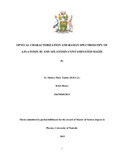| dc.description.abstract | Aflatoxins are toxic and carcinogenic chemicals produced by several fungi grown in many farm produce and food spices. The naturally produced aflatoxins by fungi Aspergillus flavus and Aspergilus parasiticus are aflatoxin B1, aflatoxin B2, aflatoxin G1 and aflatoxin G2. Aflatoxin B1 (AFB1), investigated in this work, is the most toxic, highly carcinogenic and the most widespread contaminant. The existing detection techniques are slow, expensive, involve use of chemicals, tedious sample preparation and some devices are complicated. This work reports on application of Raman spectroscopy in detecting the presence of AFB1 in maize kernels and flour. The technique promises to be rapid, non-invasive, requires no sample preparation and can be modified to be deployed in the fields. It uses laser light (here of wavelengths centred at 532 nm and 785 nm) to excite vibrational bands in the AFB1 molecules and the scattered radiation detected and measured. Maize kernels and ground samples were intentionally contaminated with AFB1 with concentrations ranging from 0 ppb to 1.1x106 ppb. Twenty two Raman peaks were identified with the most intense centred at 1552 cm-1 and 1593 cm-1. Classification and quantification of AFB1 concentrations in maize kernels and flour was achieved using the following chemometric tools: Principal Component Analysis (PCA), Partial Least Squares Regression (PLSR) and Multiple Linear Regression (MLR). PCA classified AFB1 contaminated samples based on concentration ranges (variance of > 59%). Of the models for predicting concentration PLSR performed better than MLR with R2 > 0.9. Predicted concentration values from Raman spectroscopy were found to correlate well with reference values from ELISA (P > 0.9 for 785 nm laser). Maize samples from Nairobi open markets were found to have AFB1 concentration levels of 12 ppb to 869 ppb which were higher than the permissible limits of 10 ppb in Kenya. The absorption and fluorescence spectra of AFB1 in methanol were centred and
peaked at 340 nm and 440 nm respectively and with some small maxima ascribed to vibrational bands in the first excited and ground state. | en_US |

